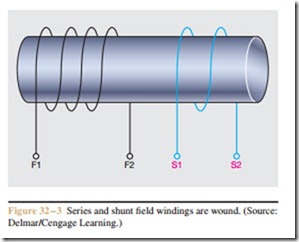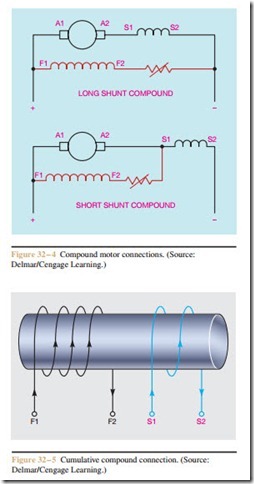Types of DC Motors
There are three basic types of DC motors: the series, the shunt, and the compound. The type of motor used is determined by the requirements of the load. The series motor, for example, can produce very high starting torque, but its speed regulation is poor. The only thing that limits the speed of a series motor is the amount of load connected to it. A very common application of a series motor is the starter motor used on automobiles. Shunt and compound motors are used in applications where speed control is essential.
Figure 32– 2 shows the basic connections for series, shunt, and compound motors. Notice that the series motor contains only the series field connected in series with the armature. The shunt motor contains only the shunt field connected parallel to the armature. A rheostat is shown connected in series with the shunt field to pro- vide above normal speed control.
The compound motor has both series and shunt field windings. Each pole piece in the motor will have both windings wound on it (Figure 32– 3). There are different ways of connecting compound motors. For instance, a motor can be connected as a long shunt compound or as a short shunt compound (Figure 32– 4). When a long shunt connection is made, the shunt field is connected
parallel to both the armature and the series field. When a short shunt connection is made, the shunt field is connected parallel to the armature, but in series with the series field.
Compound motors can also be connected as cumulative or differential. When a motor is connected as a cumulative compound, the shunt and series fields are connected in such a manner that as current flows through the windings they aid each other in the production of magnetism (Figure 32– 5). When the motor
is connected as a differential compound, the shunt and series field windings are connected in such a manner that as current flows through them they oppose each other in the production of magnetism (Figure 32– 6).

